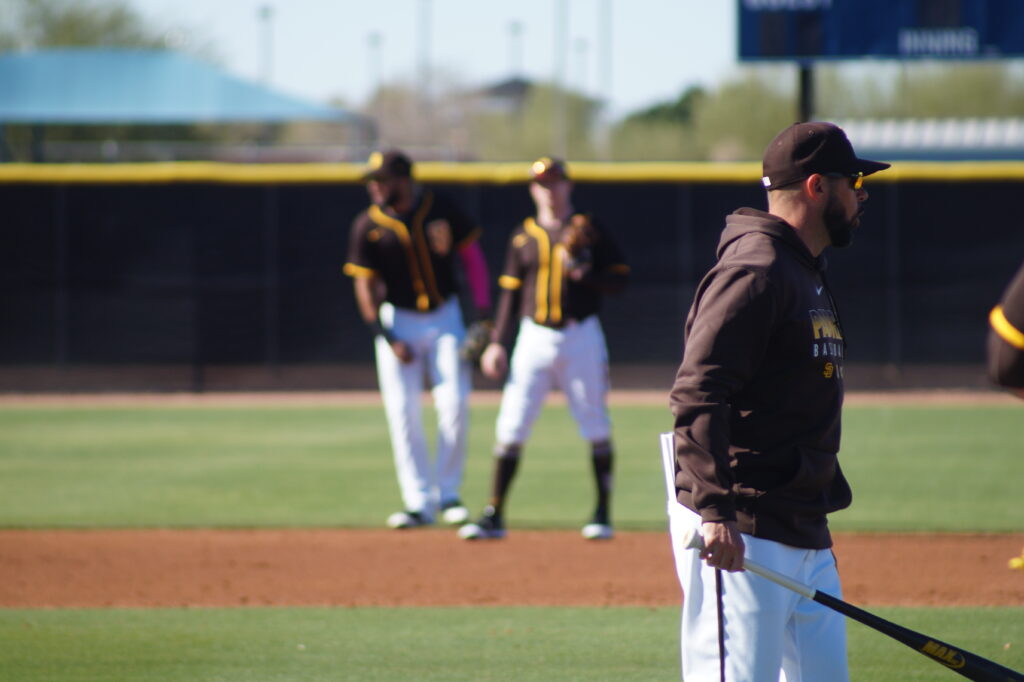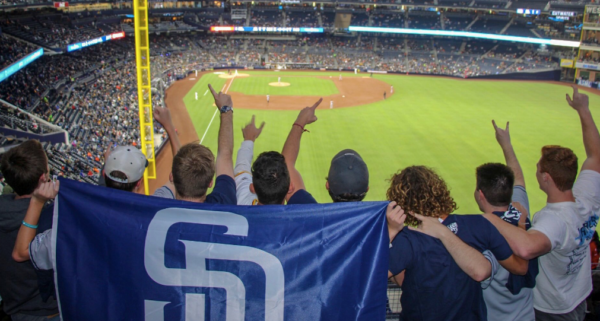Potholes on the road back to diamond for Padres and MLB

Photo Credit: Anderson Haigler/East Village Times

The San Diego Padres are not the only team that will need to adjust for an upcoming 2020 season.
For the first time since 1994, the baseball season has been canceled until further notice. Thanks to an insidious virus that has infected over 1,565,000 Americans, killing more than 93,000, Major League Baseball canceled the remainder of spring training on March 12. Since then, the league and the Major League Players Association have grappled with the advisability of playing at least part of the season. The fact that the virus has infiltrated the White House demonstrates the danger facing all of us.
Since the halt to spring training, MLB has developed a 67-page testing and safety protocol, and, after extended negotiations with the MLPA, tentative plans call for an 82-game schedule with a regional alignment and a universal designated hitter. Active rosters could include 30 players with a taxi squad of 20 more. Revenues would be split 50/50 between the owners and the players, while the postseason would consist of 14 teams.
Estimates indicate that MLB may be losing as much as $75 million a day. In 2019, the League took in $4.2 billion from the sale of tickets to t-shirts to beer. An estimated 40 percent of the revenue last year derived from fans. But, in any scenario suggested so far, fans would not figure into the equation.
For a variety of reasons, the road back to some semblance of the game we love and miss so much will be fraught with danger confounded by confusion. But, a sport that has seen a decline in attendance for four years running must be mindful of the impact of an 18-month hiatus.
As staggering as the financial costs have been, those pale in comparison to the inherent risk to players, managers, coaches, umpires, support staff, and family members. Players themselves, with an average age of 28, do not constitute a high-risk group. However, they can be dangerous, symptom-free carriers. And some players have underlying health issues, which should be a consideration.
Older participants, including managers like Dusty Baker, who is 70, club personnel, umpires, and other support staff, face a higher risk. And, what family members of players? How do the risks affect players like Mike Trout and his wife as they await the arrival of their first child in August?
Some optimists point to the resumption of baseball in South Korea early in March as a sign of hope as that country reported its first case of Covid-19 a day before the United States. However, the similarities stop there. South Korea immediately began testing for the virus, contact-tracing, and isolating infected individuals. Also, the vast majority of South Koreans willingly wear masks, but a particular segment of the American population refuses to do so.
The United States, a much larger country, reacted more slowly than South Korea and without a unified response. Federal, state, and local governments have taken varying approaches, including social distancing, which would affect venues for games. By the latest count, all but six states restrict gatherings of more than ten people.
For a variety of reasons, individual states and other locals have been harder hit by Covid-19 than the others. For instance, San Diego County has a lower incidence of the virus than Los Angeles, and that could enter into the equation. California, in general, has seen a decline in cases in the previous week, especially notable if one factor in the increase in testing. This week the governors of California, New York, and Texas indicated support for the return of professional sports.
MLB’s proposal includes regular testing of all participants from players to coaches to umpires, as well as the most essential support staff. Thanks to the shortage of test kits for Americans at large, even that requirement will be controversial. MLB has committed to walking the thin line between testing as many as 1,000 people several times a week and depriving front line workers of testing.
To add to the confusion and consternation, a player or other participant can test negative and become infected the next day. And, some researchers warn that 30 percent of negative responses should have been positive.
According to various sources, these would be the rules of engagement:
- Any player testing positive must self-quarantine.
- No one will be allowed to chew sunflower seeds or spit.
- Showers will be discouraged.
- Lockers must be six feet apart, which will require reconfiguration of many clubhouses, especially in older ballparks.
- On the road, players will be confined to their hotels.
- There will be no team meetings or exchange of lineups between managers.
- Everything from clubhouses to baseballs will be disinfected regularly.
The emphasis will be on taking personal responsibility for one’s actions, as one idiot venturing out to a crowded bar can cause a domino effect that reverberates throughout the sport. And team owners and executives should take into account the fact that they won’t be placing themselves at risk as well as the players, the coaches, and other participants will, and act accordingly.
Covid-19 has even affected the upcoming draft. The league proposed a reduction from 40 rounds to five (the fewest rounds since 1965). Players shot down the original proposal of a ten-round draft with the slot amount reduced by half in the last five rounds.
Cutting down on the draft rounds will reduce team expenditures but also hurt potential draftees, as well as small and mid-market teams. All teams will lose the opportunity to find a diamond in the rough like Jacob deGrom (drafted in the 9th round ), Trevor Hoffman (11th), Albert Pujols (13th), or Lorenzo Cain (17th).
For Padres’ fans, this virus happens along at about the worst time possible. Expectations had been high for the 2020 season. After years of losing, management had as much as promised a competitive team this year, a contending one in 2021. Fans looked forward to Fernando Tatis Jr.‘s second season, to Manny Machado‘s return to form, to Chris Paddack‘s start every five days, to welcoming top prospects like MacKenzie Gore and Luis Patino. New manager Jayce Tingler’s enthusiasm had spread throughout the baseball community.
The addition of the designated hitter to the National League, as has been proposed by MLB, could also benefit the Padres. Players like Josh Naylor and Francisco Mejia, who are more gifted at the plate than in the field, as well as those recovering from injuries like Tommy Pham, would make ideal candidates.
At a time when more than 40 million Americans find themselves without jobs, fans, even casual fans, desperately need a distraction from everyday reality. However, MLB and the MLPA must take into account the fact that even the most passionate of fans will not take kindly to billionaire owners quarreling with millionaire players over the almighty dollar.
Ironically, the only winner in this season of discontent will be the Houston Astros. The team that had been the talk of the baseball community thanks to its complicated cheating strategy that helped them claim the World Series trophy has suddenly disappeared from the radar.
Baseball has been a part of Diane’s life since her father played professionally (mostly at the minor league level). She has written for a number of publications and concentrated on companion animal welfare. She welcomes the opportunity to write about the sport she loves. Diane shares her home with her husband and a house full of rescued animals.